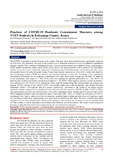| dc.description.abstract | The COVID-19 pandemic affected all areas in the country. One area whose functioning had been significantly impacted
by COVID-19 was education. The goal of this research was to determine practices of covid-19 pandemic containment
measures among TVET students in Kakamega County. Cross-sectional research was conducted using a questionnaire.
TVET students around the country filled out the survey after it was made available to them online. It was determined
whether or not there was a statistically significant correlation between KAP (knowledge and attitude) and other sociodemographic factors by using chi-square testing. Using binary logistic regression, we were able to isolate and adjust for
any confounding variables. SPSS was used for the statistical analysis (version 26). According to the respondents'
demographic information, the vast majority of participants were male. Participants' average age was under 24. Majority
of the respondents were single (n = 306, 78.1%) and were studying for diploma qualification (n = 238, 60.7%). In
addition, most of them were in their second year of study (n = 192, 49.0%). With regard to practices, at least six practices
were adhered to by 212 (54.1%) of the respondents. These eight PP include things like washing hands and using proper
hygiene (70.7%), wearing of face masks (51.0%), and avoiding public places and maintaining a safe distance between
individuals (50.9%). (74.0 percent and 64.3 percent respectively). According to the results of the binary logistic
regression, females engaged in less harmful activities than men did with respect to COVID-19 (OR = 0.323, p 0.001).
Age and academic year were also shown to have a role in the respondents' habits. Students aged 30 and over had a lower
odd of engaging in negative behaviors than those aged 24 and under (OR = 0.631, p = 0.0083). In conclusion, over half of
respondents were found to adhere to at least six measures, including hand washing and other forms of cleanliness, mask
use, avoiding crowded areas, and keeping a safe space between themselves and others. However, a sizable percentage
engaged in at least three harmful habits. Based on the findings of this research, the following are the recommended that
for future studies, it will be important to get feedback from educators as well as students. The results of such research in
the future would add to the body of data supporting the use of confinement techniques | en_US |

